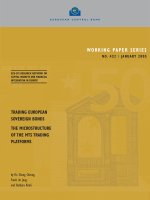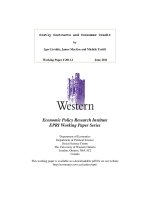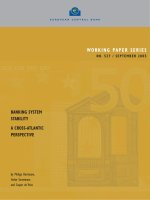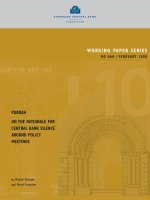WORKING PAPER SERIES NO 1487 / OCTOBER 2012: ASYMMETRIC INFORMATION IN CREDIT MARKETS, BANK LEVERAGE CYCLES AND MACROECONOMIC DYNAMICS doc
Bạn đang xem bản rút gọn của tài liệu. Xem và tải ngay bản đầy đủ của tài liệu tại đây (1.45 MB, 97 trang )
WORKING PAPER SERIES
NO 1487 / OCTOBER 2012
ASYMMETRIC INFORMATION
IN CREDIT MARKETS,
BANK LEVERAGE CYCLES AND
MACROECONOMIC DYNAMICS
Ansgar Rannenberg
NOTE: This Working Paper should not be reported as representing the
views of the European Central Bank (ECB). The views expressed are
those of the authors and do not necessarily reect those of the ECB.
,Q DOO (&%
SXEOLFDWLRQV
IHDWXUH D PRWLI
WDNHQ IURP
WKH » EDQNQRWH
MACROPRUDENTIAL
RESEARCH NETWORK
© European Central Bank, 2012
Address
Kaiserstrasse 29, 60311 Frankfurt am Main, Germany
Postal address
Postfach 16 03 19, 60066 Frankfurt am Main, Germany
Telephone
+49 69 1344 0
Internet
Fax
+49 69 1344 6000
All rights reserved.
ISSN 1725-2806 (online)
Any reproduction, publication and reprint in the form of a different publication, whether printed or produced electronically, in whole
or in part, is permitted only with the explicit written authorisation of the ECB or the authors.
This paper can be downloaded without charge from or from the Social Science Research Network electronic
library at />Information on all of the papers published in the ECB Working Paper Series can be found on the ECB’s website,
/>Macroprudential Research Network
This paper presents research conducted within the Macroprudential Research Network (MaRs). The network is composed of economists
from the European System of Central Banks (ESCB), i.e. the 27 national central banks of the European Union (EU) and the European
Central Bank. The objective of MaRs is to develop core conceptual frameworks, models and/or tools supporting macro-prudential
supervision in the EU.
The research is carried out in three work streams: 1) Macro-nancial models linking nancial stability and the performance of the
economy; 2) Early warning systems and systemic risk indicators; 3) Assessing contagion risks.
MaRs is chaired by Philipp Hartmann (ECB). Paolo Angelini (Banca d’Italia), Laurent Clerc (Banque de France), Carsten Detken
(ECB), Cornelia Holthausen (ECB) and Katerina Šmídková (Czech National Bank) are workstream coordinators. Xavier Freixas
(Universitat Pompeu Fabra) and Hans Degryse (Katholieke Universiteit Leuven and Tilburg University) act as external consultant.
Angela Maddaloni (ECB) and Kalin Nikolov (ECB) share responsibility for the MaRs Secretariat. The refereeing process of this paper
has been coordinated by a team composed of Cornelia Holthausen, Kalin Nikolov and Bernd Schwaab (all ECB).
The paper is released in order to make the research of MaRs generally available, in preliminary form, to encourage comments and
suggestions prior to nal publication. The views expressed in the paper are the ones of the author(s) and do not necessarily reect those
of the ECB or of the ESCB.
Acknowledgements
I would like to thank Charles Nolan, Gregory de Walque, Hans Dewachter, Jens Iversen, Luc Laeven, Philipp Hartmann, Raf Wouters,
Skander van den Heuvel and participants at the 2011 conference of Macroprudential Research (MaRs) network for helpful discussions.
Ansgar Rannenberg
at Macroeconomic Policy Institute (IMK); email:
Abstract
I add a moral hazard problem between banks and depositors as in Gertler and Karadi (2009)
to a DSGE model with a costly state veri…cation problem between entrepreneurs and banks
as in Bernanke et al. (1999) (BGG). This modi…cation ampli…es the response of the external
…nance premium and the overall economy to monetary policy and productivity shocks. It
allows my model to match the volatility and correlation with output of the external …nance
premium, bank leverage, entrepreneurial leverage and other variables in US data better than
a BGG-type model. A reasonably calibrated combination of balance sheet shocks produces
a downturn of a magnitude similar to the "Great Recession".
JEL Codes: E44, E43, E32.
Keywords: Leverage cycle, bank capital, financial accelerator, output effects of financial shocks
Non-technical summary
The ongoing financial crisis has drawn renewed attention to the relationship between bank capital and
economic activity. In its Global Financial Stability report of April 2010, the IMF argues that the losses
incurred by banks caused a contraction in credit supply which in turn contributed to the economic
downturn in the United States and beyond. Several empirical studies find that negative shocks to the
capital of banks reduce lending and economic activity. At the same time, there is a long line of evi-
dence saying that investment spending is positively related to the net worth of non-financial firms. All
these considerations have led to a strong interest in better understanding the aggregate leverage cycle,
in particular in relation to banks and non-financial firms.
This paper makes a contribution to the leverage-cycle debate by combining a costly state verification
problem between borrowing entrepreneurs (the agents accumulating the capital stock) and banks as in
traditional financial accelerator models with a moral hazard problem between banks and depositors.
Therefore the leverage of both the borrowing entrepreneur and the bank lending to him affect the
spread between the interest rate on loans and the risk free rate, i.e. the external finance premium, and
hence the price of capital goods and investment.
The bank's leverage constraint arises because, after collecting household deposits, a bank can divert a
fraction of its assets and declare bankruptcy. Therefore the bank will only be able to attract household
deposits if its expected lifetime profitability is sufficiently high such that it has no incentive to divert
assets. Hence an increase in the bank's today's leverage and thus the benefit to divert assets has to be
matched by an increase in lifetime profitability and thus an increase in the expected profit margin on
bank loans. Furthermore, a decline in expected future bank leverage relative to today’s also requires an
increase in the expected profit margin. Low expected future loan demand relative to the bank's own
funds lowers the bank's expected lifetime profitability and thus restricts today's loan supply. Thus an
expected banking sector de-leveraging increases today’s external finance premium.
Both a monetary tightening and an adverse productivity shock trigger a banking sector de-leveraging.
Therefore the response of the external finance premium and thus output and investment both to a mon-
etary tightening and an adverse productivity shock is amplified as compared to a conventional finan-
cial accelerator-type model where only the leverage of entrepreneurs drives the external finance pre-
mium. This amplification allows the model to match the volatility of the external finance premium, in-
vestment and other variables relative to output in US data better than a conventional financial accelera-
tor model even in the absence of any financial shocks. At the same time, the model developed in this
paper also matches the volatility and procyclicality of bank leverage.
Regarding the effect of financial shocks in this model, a negative shock to the net worth of entrepre-
neurs causes a deeper downturn than in a conventional financial accelerator model. The increase in en-
trepreneurial borrowing and leverage associated with the sudden loss of funds increases the external
finance premium in a conventional financial accelerator model. The increase in entrepreneurial bor-
rowing in turn requires an increase in bank lending and hence bank leverage, which, in the presence of
a leverage constraint in the banking sector, requires a further increase in the external finance premium.
Furthermore, the bank leverage constraint implies that a negative shock to the net worth of banks
causes an economic downturn. The reduction in their net worth forces banks to cut their supply of
loans, which increases the external finance premium. Both the shock to firm net worth and bank net
worth resemble demand shocks in that they move output and inflation in the same direction. This is in
line with recent euro-area evidence by Ciccarelli et al. (2011).
A reasonably calibrated combination of shocks to the balance sheets of banks and entrepreneurs causes
a downturn of a magnitude similar to the “Great Recession” associated with the 2007-2009 financial
crisis the United States. Previous dynamic stochastic general equilibrium models, which exhibited no
or focused on single financial frictions and did not take the interaction between bank and firm leverage
into account, encountered great difficulties in matching the experience of the crisis. In sum, for under-
standing the macroeconomic sources and implications of widespread financial instability it is essential
that macroeconomic models are equipped with rich characterisations of financial sectors, including the
multiplicity of frictions that may emerge in them, and how they interact with the debt dynamics of ma-
jor economic agents.
1 Introduction
The ongoing …nancial crisis has drawn renewed attention to the relationship between bank
capital and economic activity. In its Global Financial Stability report, the IMF argues that
the losses incurred by banks caused a contraction in credit supply which in turn contributed
to the economic downturn in the United States and beyond. Several empirical studies …nd
that negative shocks to the capital of banks reduce lending and economic activity.
1
At the
same time, there is a long line of evidence saying that investment spending is positively
related to the net worth of non-…nancial …rms.
2
Therefore, I develop a model where both bank and …rm leverage matter for the cost of
external funds of …rms and thus aggregate demand. I combine a costly state veri…cation
(CSV) problem between borrowing entrepreneurs (the …rms accumulating the capital stock),
as in the well known Bernanke et al. (1999) (henceforth referred to as BGG) …nancial
accelerator model, with a moral hazard problem between banks and depositors as in the more
recent contribution of Gertler and Karadi (201s). I assume that after collecting household’s
deposits, banks can divert a fraction of its assets and declare bankruptcy. Therefore the
bank will only be able to attract deposits from households if its’ expected pro…tability is
su¢ ciently high such that it has no incentive to divert assets and thus household deposits are
safe. This implies that the banks’ability to attract deposits and thus to expand loans today
is positively related to its current net worth and its expected future earnings. If a shock
lowers current bank net worth or future loan demand and thus future earnings, individual
banks will have to cut loan supply today. Thus an expected banking sector de-leveraging
1
See Peek and Rosengreen (1997,2000), Ciccarelli et al. (2011) and Fornari and Stracca (2011).
2
See Hubbard (1998) for a survey.
1
increases the cost of external …nance today.
My main results can be summarized as follows. First, as compared to a BGG-type model,
the response of the economy both to a monetary tightening and an adverse productivity
shock is ampli…ed in my model, the former more so than the latter. Both shocks trigger a
deleveraging process in the banking sector, implying that banks cut loan supply when the
shocks occur, thus amplifying the increase in the cost of external …nance relative to the BGG
model.
Secondly, in a world with three standard shocks (productivity, monetary policy and gov-
ernment spending), the ampli…cation provided by the moral hazard problem in the bank-
depositor relationship allows the model to match the volatility of the external …nance pre-
mium, investment and other variables relative to output in US data better than the BGG
model. My model also performs well at matching the second moments of the bank capital
ratio.
Thirdly, in my model, an adverse shock to entrepreneurial net worth causes an output
contraction more than twice as big as in a BGG-type model. In line with the existing empirical
evidence, an adverse shock to bank net worth causes a persistent decline of GDP. The shock
decreases loan supply by individual banks and thus increases the cost of external …nance.
For a reasonably calibrated combination of both net worth shocks, the model economy enters
a downturn of a persistence and magnitude similar to the ongoing "Great Recession" in the
United States.
The model has a number of desirable features not present in some recently proposed
DSGE models with leverage constraints both in the …rm and in the banking sector. First,
…rms and banks are subject to microfounded leverage constraints, unlike in the models of
2
Gerali et al. (2010) and Dib (2010). Furthermore, the capital stock in my model is owned
by entrepreneurs who fund it using their own net worth and bank loans. Thus the leverage
constraints banks and entrepreneurs have to obey apply to the whole capital stock. By
contrast, in Meh and Moran (2010), households accumulate the capital stock and merely the
production of new capital needs to be funded by entrepreneurial net worth and bank loans.
Moreover, in my model households require the bank liabilities they hold to be riskless and
withdraw their funds otherwise, as is arguably realistic. By contrast, in the models of Meh
and Moran (2010) and Hirakata et al. (2009), depositors deliberately take a default risk and
price it into the deposit rate.
3
Furthermore, in my model entrepreneurs may default with a
cyclically varying probability, a feature absent in Meh and Moran (2010) and Gerali et al.
(2010). Finally, the model can easily be extended to analyse the merits of the unconventional
monetary policy responses to …nancial crises considered by Gertler and Karadi (2011) and
Gertler and Kiyotaki (2009) and of the macroprudential p olicies considered in Gertler and
Kiyotaki (2010), as well as the e¤ect of frictions in the interbank market considered in Gertler
and Kiyotaki (2009).
The remainder of the paper is organized as follows. Section 2 develops the model. Section
3 discusses the calibration while section 4 compares the response of my model and a BGG
type model to three standard shocks. Section 5 performs a moment comparison, while section
6 summarizes the result from a series of robustness checks performed in the appendix. Section
7 discusses the response of the economy to …nancial shocks.
3
In Meh and Moran (2010), they even fund a speci…c entrepreneurial investment project jointly with the
bank.
3
2 The model
Sections 2.1 to 2.3 discuss the real side of the economy, while sections 2.5 and 2.4 discuss
the banking and entrepreneurial sector. The …rst order conditions of households, investment
good producers and retailers have been relegated to the appendix since these aspects of the
model are standard. Section D of the appendix summarizes the linearized equations of the
three model variants considered in this paper.
2.1 Households
The economy features a large representative household with preferences described by the
intertemporal utility function
E
t
(
1
X
i=0
i
ln (C
t+i
hC
t+i1
)
1 + '
l
s
t+i
1+'
)
where C
t
and l
s
t
denote a CES basket of consumption good varieties and labour e¤ort, re-
spectively, and h denotes the degree of external habit formation. The household saves by
depositing funds with banks and by buying government bonds. Both of these assets have
a maturity of one quarter, yield a nominal return and, in the equilibrium considered here,
are perfectly riskless in nominal terms. Thus they are perfect substitutes and earn the same
interest rate. I denote the total …nancial assets of households at the end of period t-1 as B
T
t1
and the interest rate paid on these assets in period t as R
t1
:
Following Schmitt-Grohe and Uribe (2005), I assume that a central authority inside the
household, a union, supplies labour to a continuum of labour markets indexed by j = [0; 1],
4
with l
t
(j) denoting the labour supplied to market j and
l
s
t
=
Z
1
0
l
t
(j) dj: (1)
Labour packers operating under perfect competition buy these varieties at a wage W
t
(j)
and aggregate them into a CES basket. Cost minimization by the labour packer implies a
demand curve for variety j given by l
t
(j) =
W
t
(j)
W
t
"
w
l
t
; where W
t
and "
w
denote the price
index of the labour basket and the elasticity of substitution between varieties, respectively.
W
t
is given by
W
t
=
"
Z
1
0
W
1"
w
t
(j) dj
1=(1"
w
)
#
(2)
The union takes W
t
and l
t
as given and sets W
t
(j) such that the households utility is
maximized. I assume that in doing so, it is subject to nominal rigidities in the form of
Calvo contracts. Each period, the union can reset the wage optimally in a fraction 1
w
of
randomly chosen labour markets. In these markets, wages are indexed to lagged and average
in‡ation according to the rule W
t
(j) = W
t1
(j)
1
w
w
t1
; where
t
=
P
t
P
t1
and P
t
denotes
the price of the CES basket underlying consumption. Using (2), the law of motion of the
aggregate nominal wage is given by
W
t
=
(1 )
f
W
t
1"
+
w
W
t1
1
P
(
t1
)
P
1"
w
1
1"
w
where
f
W
t
denotes the wage in markets where wages are optimally reset.
Households also derive pro…t income from owning retail …rms and capital good’s produc-
5
ers. Hence their budget constraint is given by
P
t
C
t
= P
t
l
t
Z
1
0
w
t
(j)
w
t
(j)
w
t
"
w
dj + P
t
prof
t
+ P
t
T
t
+ R
t1
B
T
t1
B
T
t
(3)
where C
t
, w
t
;
t
and T
t
denote consumption, the real wage, real pro…ts and real lump sum
taxes, respectively.
2.2 Capital goods producers
Capital goods producers are owned by households. They produce new capital goods using a
technology which yields 1
i
2
I
t
I
t1
1
2
capital goods for each unit of investment expen-
ditures I
t
. Capital goods are sold to entrepreneurs at currency price P
t
Q
t
: Real expected
pro…ts of the capital goods producer are then given by
E
t
(
1
X
i=0
%
t+i
%
t
i
I
t+i
"
Q
t+i
1
i
2
I
t+i
I
t+i1
1
2
!
1
#)
where %
t
denotes the marginal utility of real income of the household.
2.3 Retailers
The varieties of goods forming the CES basket are produced by a continuum of retail …rms
indexed by i. Each retailer operates under monopolistic competition and is owned by house-
holds, with the demand for its product given by
Y
t
(i) =
p
t
(i)
P
t
"
Y
t
6
where " > 1 denotes the elasticity of substitution between varieties. Retailers hire labour
l
t
(i) at real wage w
t
from labour packers and capital services K
s
t
(i) at renal rate r
k
t
from
entrepreneurs in economy-wide factor markets. Hence the output of …rm i is given by
Y
t
(i) = (K
s
t
(i))
(exp (a
t
) l
t
(i))
1
where a
t
denotes a transitory technology shock with mean zero following an AR(1) process. I
assume that retail …rms have to pay fractions
L
and
K
; respectively, of their expenditures
on labour and capital services in advance and borrow from banks to do so. I show in section
2.4 that the interest rate on these loans equals the risk-free rate R
t
. The loans are paid back
at the end of period t. Hence, total working capital loans to retailers L
r
t
are given by
L
r
t
=
L
w
t
l
t
+
K
r
k
t
K
s
t
(4)
Retailers are subject to nominal rigidities in the form of Calvo (1983) contracts: Only a
fraction 1
P
is allowed to optimize its price in a given period. Those …rms not allowed to
optimize its price index it to past in‡ation at a rate
P
and to the steady-state in‡ation rate
at rate 1
P
: Denoting the price chosen by those …rms allowed to optimize in period t
as p
t
; the aggregate price index evolves according to
P
t
=
h
1
P
(p
t
)
1"
+
P
P
t1
1
P
(
t1
)
P
1"
i
1
1"
7
2.4 Banks
Following Gertler and Karadi (2011), some households in the economy are bankers. They are
risk-neutral and die with a …xed probability 1 after earning interest income on the loans
they made in the previous perio d. This assumption ensures that banks never become fully
self-…nancing. The fraction 1 of bankers who die are replaced by newly born bankers.
4
If banker q dies, he consumes his accumulated end-of-perio d t real net worth N
b
t
(q). Dying
bankers are replaced by new ones who receive a transfer N
b
n
from households.
Banks derive income from o¤ering loans to …rms. This is a key di¤erence with respect
to Gertler and Karadi (2011), where banks channel funds to …rms by buying equity stakes.
A banker makes two types of loans. The …rst type are risky inter-period loans L
e
t
(q) to
entrepreneurs who need to buy their period t+1 capital stock. These loans are due at
beginning of period t+1. The second type are riskless intraperiod working capital loans L
r
t
to retailers who need to pay for the labour and capital services used in production and are
due at end of period t.
Following Gertler and Karadi (2011), I assume that after collecting deposits, a banker can
choose to divert some of his assets for his own consumption. Speci…cally, a banker can divert
fraction 0 1 of loans to entrepreneurs and consume it. In this case, the banker declares
bankruptcy and households recover the remaining assets. This implies that households will
only make deposits if the banker has no incentive to default, i.e. if V
b
t
(q) L
e
t
(q) ; where
4
I di¤er from Gertler and Karadi (2010) in assuming that banks are separate risk neutral agents. Gertler
and Karadi (2010) assume that banks are owned by households and transfer their terminal wealth to their
household. I adopt the assumption of risk neutral bankers because a risk averse bank would complicate the
problem of the entrepreneur.
8
V
b
t
(q) denotes present value of banker q0s expected real terminal wealth:
V
b
t
(q) = E
t
8
>
>
>
>
>
<
>
>
>
>
>
:
1
X
i=0
(1 )
i
0
B
B
B
B
B
@
1
i
Y
j=0
R
r
t+1+j
1
C
C
C
C
C
A
N
b
t+1+i
(q)
9
>
>
>
>
>
=
>
>
>
>
>
;
; R
r
t+1
=
R
t
t+1
The fact that household only make deposits if the banker has no incentive to divert assets
implies the bank never defaults and thus household dep osits are riskless in equilibrium.
By contrast, in the management of intraperiod loans, there is no moral hazard problem
between bankers and depositors and also no friction in bank-retailer relationship. Hence the
loan rate is driven down to the deposit rate, implying that banks earn zero pro…ts on these
loans. Thus the intraperio d loan business does not a¤ect N
b
t
(q) and V
b
t
(q) ; and thus has no
impact on lending to entrepreneurs.
Let B
t
(q) be the amount of nominal deposits collected by the bank in order to fund
interperiod loans. It follows that P
t
L
e
t
(q) = P
t
N
b
t
(q) + B
t
(q) and that the law of motion of
banker q’s net worth is given by
P
t
N
b
t
(q) =
R
b
t
P
t1
L
e
t1
(q) R
t1
B
t1
(q)
exp (e
z
t
) (5)
= P
t1
R
b
t
R
t1
L
e
t1
(q) + R
t1
N
b
t1
(q)
exp (e
z
t
) (6)
where R
b
t
denotes the average return the bank earns on the portfolio of loans to entrepreneurs
made in period t 1 net of any costs associated with entrepreneurial bankruptcy. e
z
t
denotes
an exogenous i.i.d. shock to the capital of existing banks, which I will use below to simulate
the e¤ect of a banking crisis on the macroeconomy.
9
Like Gertler and Karadi (2011), I will calibrate such that the incentive compatibility
constraint binds locally in equilibrium, hence V
b
t
(q) = L
e
t
(q) : Appendix A.4, shows that in
equilibrium, all banks chose the same ratio between loans to entrepreneurs and their own net
worth. Hence we have L
e
t
=
b
t
N
b
t
; where L
e
t
and N
b
t
denote total loans to entrepreneurs and
total bank net worth, respectively.
b
t
is determined by a complicated non-linear expression,
which up to …rst order however reduces to one equation as we discuss below. In much of
the discussion, I will refer to
b
t
as bank leverage since its dynamics are both crucial for my
results and are the main driver of total leverage, the ratio of total loans to bank net worth
L
t
N
b
t
:
N
b
t
consists of the net worth of bankers already in business in period t-1 who did not die
at the beginning of period t N
b
et
and the net worth of new bankers N
b
n
, i.e.
N
b
t
= N
b
et
+ N
b
n
N
b
et
is given by
N
b
et
= z
t1;t
N
b
t1
(7)
z
t1;t
=
R
b
t
R
t1
b
t1
+ R
t1
t
exp (e
z
t
) (8)
where z
t1;t
denotes the growth rate of real net worth of bankers already in business in period
t 1 who did not die at the beginning of period t. The consumption of dying bankers is
given by
C
b
t
= (1 ) z
t1;t
N
b
t1
(9)
10
For future reference, it will be useful to divide both sides of the incentive constraint L
e
t
(q) =
V
b
t
(q) by N
b
t
(q) ; which yields
b
t
=
V
b
t
N
b
t
:
V
b
t
N
b
t
can be interpreted as a measure of pro…tability,
as it is the ratio of the expected value of being a banker to the own funds of the bank as
of period t which generate this value. In appendix B, I show that up to …rst order, this
constraint can be expressed as
b
b
t
=
\
V
b
t
N
b
t
=
1
X
i=0
2
z
2
i
b
R
b
R
E
t
b
R
b
t+1+i
b
R
t+i
(10)
with
b
b
t
=
b
L
e
t
b
N
b
t
: Hence bank leverage depends positively on the exp ected weighted sum of
pro…t margins on loans made in period t and after
b
R
b
t+1+i
b
R
t+i
: The intuition behind this
relation is as follows. If the pro…t margin on loans made in period t and/ or after increases,
this raises the pro…tability of the bank
\
V
b
t
N
b
t
: This in turn reassures depositors that the bank
has no incentive to default and thus they are willing to buy more deposits. Hence the bank
can expand its lending to entrepreneurs and its leverage
b
b
t
: Therefore equation (10) may be
interpreted as a "credit supply curve". The di¤erence with respect to a more conventional
supply curve is that it relates the supply of loans in period t not simply to the expected
pro…t margin on loans made in period t but to the pro…tability of the bank and thus to the
expected pro…t margins on both period t and future loans.
The forward looking nature of loan supply implies that future loan market equilibria have
a direct e¤ect on period t loan supply. Imagine that in some future period t + i loan demand
is low relative to the own funds of the bank and thus
b
b
t+i
is low, moving the bank down
its supply curve. This implies that bank pro…tability as of period t + i
\
V
b
t+i
N
b
t+i
declines. As
a consequence, period t pro…tability
\
V
b
t
N
b
t
and thus the amount of deposits households are
11
willing to make declines. The loss of funds lowers
b
b
t
and thus period t loan supply. As we
will see below, this mechanism has important consequences for the response of the economy
to shocks.
2.5 Entrepreneurs
Investment decisions in the economy are made by risk-neutral entrepreneurs. My assumptions
regarding this sector follows Christiano et al. (2010), unless otherwise noted. At the end
of period t, entrepreneur j buys capital K
j
t
for price P
t
Q
t
: In period t + 1, they rent part
of their capital stock to retailers at a rental rate P
t+1
r
k
t+1
and then sell the non-depreciated
capital stock at price P
t+1
Q
t+1
: They are subject to capacity utilization costs a (U
t+1
) ; where
a
0
(:) > 0; a
00
(:) > 0; a
0
(1) = r
k
and a
00
(1) = c
U
r
k
: The average return to capital across
entrepreneurs is given by
R
K
t+1
=
t+1
r
k
t+1
U
t+1
a (U
t+1
) + Q
t+1
(1 )
Q
t
(11)
where the optimal choice of U
t
implies that
r
k
t
= a
0
(U
t
) (12)
The gross nominal return of entrepreneur j is given by !
j
t+1
R
K
t+1
; where !
j
t+1
is an idiosyncratic
shock creating ex-post heterogeneity among entrepreneurs with density f (!
j
) ; mean 1 and
variance
2
:
To fund the acquisition of the capital stock, the entrepreneur uses his own net worth P
t
N
j
t
12
and a loan P
t
L
j
t
= P
t
Q
t
K
j
t
N
j
t
; which is granted by the bank at a gross nominal loan
rate R
L
t
: Loan and interest are paid back in period t+1.
In case of default, i.e. if the realisation of !
j
t+1
R
K
t+1
is so low that the entrepreneurs
can not repay the loan, the bank seizes the entrepreneurs assets !
j
t+1
R
K
t+1
K
j
t
P
t
Q
t
but has
to pay a fraction thereo¤ as bankruptcy cost. Hence one can de…ne a cut-o¤ value !
j
t+1
for !
j
t+1
such that for values of !
j
t+1
greater or equal to !
j
t+1
; the entrepreneur is able to
repay the loan: !
j
t+1
R
K
t+1
P
t
Q
t
K
j
t
= R
L
t
P
t
L
j
t
: Furthermore, after the realisation of !
j
t+1
R
K
t+1
entrepreneurs die with a …xed probability 1 : Dying entrepreneurs consume their equity
V
t
. The fraction 1 of entrepreneurs who died are replaced by new entrepreneurs each
period. This assumption ensures that entrepreneurs never become fully self-…nancing.
At the very beginning of period t+1, after the realization of aggregate uncertainty and in
particular R
K
t+1
but before the realization of !
j
; the expected revenue of the bank associated
with a loan L
j
t
is given by
Loanrev
j
t+1
= R
L
t
P
t
L
j
t
Z
1
!
j
t+1
f
!
j
d!
j
+ (1 )R
K
t+1
P
t
Q
t
K
j
t
Z
!
j
t+1
0
!
j
f
!
j
d!
j
(13)
where the …rst term refers to the bank’s revenue in case of non-default and the second term
refers to the case of default. The expected revenue associated with loan L
j
t
as of period t, on
the other hand, is given by E
t
(
R
L
t
P
t
L
j
t
Z
1
!
j
t+1
f (!
j
) d!
j
+ (1 )R
K
t+1
P
t
Q
t
K
j
t
Z
!
j
t+1
0
!
j
f (!
j
) d!
j
)
where expectations are taken over R
K
t+1
and !
j
t+1
.
In the previous section I showed that given current demand for loans and the bank
leverage it implies, as well as expected pro…t margins on loans made in future periods, the
incentive compatibility constraint faced by the banker pins down the required expected return
13
on loans made to entrepreneurs E
t
R
b
t+1
(see equation (10)). Any debt contract between the
entrepreneur and the bank
L
j
t
; R
L
t
has to yield an expected revenue to the bank such that
its expected return on these loans equals E
t
R
b
t+1
: Hence the participation constraint of banks
in the market for loans to entrepreneurs is given by
E
t
(
R
L
t
P
t
L
j
t
Z
1
!
j
t+1
f
!
j
d!
j
+ (1 )R
K
t+1
P
t
Q
t
K
j
t
Z
!
j
t+1
0
!
j
f
!
j
d!
j
)
= P
t
L
j
t
E
t
R
b
t+1
(14)
Note that unlike in Christiano et al. (2010)’s version of the BGG model, the loan rate
is not state contingent but …xed, i.e. it does not vary with the realisation of R
K
t+1
: Hence
unexpected aggregate shocks will a¤ect the return on bank loans via the implied unexpected
losses which where not priced into the loan rate when the debt contract was made. Here I
follow Zhang (2009). By contrast, in Christiano et al. (2010), the loan rate varies depending
on the realisation of R
K
t+1
in order to guarantee the bank a nominal return equal to the risk
free rate. Hence in their model, the following constraint has to hold in every t+1 aggregate
state:
P
t
L
j
t
R
t
= R
L
t+1
P
t
L
j
t
Z
1
!
j
t+1
f
!
j
d!
j
+ (1 ) R
K
t+1
P
t
Q
t
K
j
t
Z
!
j
t+1
0
!
j
f
!
j
d!
j
However, while adding realism to the setup, the introduction of non-statecontingent contracts
has only minor e¤ects on the quantitative results.
The entrepreneurs chooses the level of K
j
t
and thus implicitly a pair
L
j
t
; R
L
t
to maximize
14
his exp ected return, which is given by
E
t
(
Z
1
!
j
t+1
f
!
j
!
j
R
K
t+1
P
t
Q
t
K
j
t
R
L
t
P
t
L
j
t
d!
j
)
In appendix A.5, I show that all entrepreneurs choose the same leverage
e
t
=
Q
t
K
t
N
t
and
derive the …rst order conditions. Up to …rst order, these equations give rise to a relationship
between E
t
R
K
t+1
=E
t
R
b
t+1
and the entrepreneurial leverage ratio identical to the relationship
between the risk premium E
t
R
K
t+1
=R
t
and the leverage ratio in BGG:
E
t
b
R
K
t+1
E
t
b
R
b
t+1
=
l
b
K
t
+
b
Q
t
b
N
t
(15)
where
l
0. Hence in the presence of both a CSV problem between …rms and banks and
the moral hazard problem between banks and depositors assumed here, E
t
b
R
K
t+1
b
R
t
consists
of two spreads, E
t
b
R
b
t+1
b
R
t
and E
t
b
R
K
t+1
E
t
b
R
b
t+1
: E
t
b
R
b
t+1
b
R
t
is driven by bank leverage
as detailed in the previous subsection while E
t
b
R
K
t+1
E
t
b
R
b
t+1
is driven by entrepreneurial
leverage.
Total entrepreneurial net worth at the end of period t consists of the part of entrepre-
neurial equity V
t
not consumed by dying entrepreneurs and a transfer from households to
entrepreneurs W
e
:
N
t
= V
t
+ W
e
(16)
15
Entrepreneurial equity and consumption are given by
V
t
=
Z
1
!
t
f
!
j
!
j
R
K
t
Q
t1
K
t1
R
L
t1
L
e
t1
d!
j
exp
e
N
t
(17)
C
e
t
= (1 ) V
t
(18)
where e
N
t
denotes an exogenous i.i.d. shock to aggregate entrepreneurial net worth.
The period t cut-o¤ value of ! dividing the population of …rms into bankrupt and solvent
denoted by !
t
is given by
!
t
=
R
L
t1
(Q
t1
K
t1
N
t1
)
R
K
t
Q
t1
K
t1
(19)
Note that the lending rate is predetermined, implying that only R
K
t
has a contemporaneous
e¤ect on
!
t
: Finally, dividing both sides of 13 by P
t
L
j
t
, iterating one period back and using the
fact that entrepreneurial leverage and the cut-o¤ value !
j
t
are the same across entrepreneurs
as well as the law of large numbers, we have
R
b
t
=
Loanrev
j
t
P
t1
L
j
t1
=
R
L
t1
Z
1
!
t
f
!
j
d!
j
+ (1 )R
K
t
e
t1
e
t1
1
Z
!
t
0
!
j
f
!
j
d!
j
(20)
for the average return on on loans to entrepreneurs made in period t-1.
16
2.6 Monetary policy and equilibrium
Monetary policy sets the risk free interest rate, and thus the deposit rate, following an interest
feedback rule of the form
R
t
1 = (1
i
)
2
6
6
4
R 1 +
E
t
(log (
t+1
) log ())
+
(log (
t
) log (
t1
)) +
y
(log (GDP
t
) log (GDP
t1
))
3
7
7
5
(21)
+
i
(R
t1
1) + e_i (22)
where e_i denotes an i.i.d. monetary policy shock. This rule is taken from Christiano et al.
(2010). I will draw on this paper to calibrate many of the model’s parameters, including the
monetary policy rule.
The resource constraint is given by
S
t
= (1
P
)
t
t
"
+
P
t
P
t1
1
P
"
S
t1
(23)
C
P
t
= C
t
+ C
e
t
+ C
b
t
(24)
Y
t
= S
t
0
B
B
@
I
t
+ C
P
t
+ Gov
t
+a (U
t
) K
t1
+
R
K
t
t
Q
t1
K
t1
Z
!
t
0
!f (!) d!
1
C
C
A
(25)
Y
t
= (K
t1
U
t
)
(A
t
l
t
)
1
(26)
GDP
t
= I
t
+ C
t
+ Gov
t
(27)
where S
t
denotes the e¢ ciency loss arising from price dispersion and Gov
t
denotes government
17
expenditure. The law of motion of capital is given by
K
t
= (1 ) K
t1
+ I
t
1
i
2
I
t
I
t1
1
2
!
(28)
2.7 Two simpli…cations of the full model
Below I will compare the response of the model developed in this paper to two simpli…ed
versions. The …rst is a BGG model with a passive banking sector. Speci…cally, I assume that
there is no moral hazard problem b etween bankers and depositors ( = 0) and assume that
the loan rate on loans made in period t adjusts after period t+1 shocks are realized in order
to ensure that the bank receives a risk free nominal return, which, with = 0; equals the
risk free rate R
t
. Hence this model features a …nancial accelerator as in Christiano (2010).
The presence of the passive banking sector has no impact on dynamics of the real economy.
However, it will be helpful to understand why the economy responds di¤erently to shocks
once > 0: The second version is a model where households accumulate the capital stock K
t
in order to rent it to retailers in period t+1. Hence apart from the working capital constraint
on retailers, there are no …nancial frictions.
3 Calibration
I calibrate the model to US data over the period from 1990Q1-2010Q1 All data sources
are described in appendix G. After setting equal to the average percentage change in
the GDP de‡ator, is set such that the deposit rate R equals the average federal funds
rate. Some of the parameters pertaining to the various …nancial frictions in the banking and
18
entrepreneurial sector are calibrated such that the steady state values of important …nancial
variables in the model equal averages of certain …nancial data time series for the …nancial
and non-farm business sector. This route is also followed by Christiano et al. (2010), Meh
and Moran (2010), Nolan and Thoenissen (2009) and Bernanke et al. (1999). Each of the
targets is displayed in table 3.
The parameters pertaining to the entrepreneurial sector are ; , and W
e
: is set
to lie in the range of estimates of bankruptcy costs cited by Carlstrom and Fuerst (1997).
is calibrated such that …rm leverage
e
and the default rate F meet target values. The
target for the probability of default is taken from Bernanke et al. (1999). The target for
…rm leverage is the average ratio between total liabilities and total net worth of the nonfarm
non…nancial business sector, taken from the Flow of Funds account (FFA) of the Federal
Reserve Board.
5
is calibrated close to values used by Christiano et al. (2010) and Bernanke
et al. (1999), which backs out the transfer to new entrepreneurs W
e
:
The parameters pertaining to the banking sector are the fraction of loans the bank can
divert , the survival probability of banks and the transfer to new bankers W
b
. They are
calibrated to meet targets for the cost of external …nance of entrepreneurs R
L
R; the bank
capital ratio
N
b
L
and probability of bank death 1 : The target for R
L
R is an estimate
of Levin et al. (2006), who estimate the cost of external …nance of 796 publicly traded
non…nancial companies over the period 1997Q1 to 2004Q4. They match the daily e¤ective
yield on each individual security issued by the …rm to the estimated yield on a treasury coupon
5
Both net worth and total liabilities are summed up across the non-farm business sector. The resulting
leverage ratio is 1.85. A more restrictive measure of net worth suggested by Fuentes (2009) substracts total
credit market instruments from total tangible (as opposed to …nancial) assets. This measure implies a leverage
ratio of 1.7, which is still close to the target under the baseline calibration. Setting the target for
e
to 1.7
has small e¤ects on the numerical results reported below, which however all go in the direction of somewhat
strengthening my conclusions, in particular regarding the performance of the two models relative to the data.
19
security of the same maturity, and also correct for the di¤erential tax treatment of government
and corporate bonds. The target for
N
b
L
is the average ratio between tangible common equity
(TCE) and risk weighted assets (RWA) of Federal Deposit Insurance Corporation (FDIC)
insured institutions. Among available empirical measures of bank net worth, TCE comes
closest to the de…nition of bank net worth in my model. The calculation of RWA attaches
weights between 0 and 1 to individual assets according to their risk and liquidity as speci…ed
by the Basel I agreement. The probability of bank death 1 is set close to the median
probability of bank default as estimated by Carlson et al. (2008) over the sample period.
I assume that retailers have to fully pre-…nance their capital and labour costs via working
capital loans, i.e.
L
=
K
= 1:
Most parameters not p ertaining to the …nancial frictions in the model are calibrated
according to choices and estimates of Christiano et al. (2010), who estimate a model with
a …nancial accelerator. Exceptions are the cost of changing capacity utilization, c
U
, and the
cost of adjusting investment,
i
; where Christiano et al.’s estimates are unusually high.
In the moment comparison I will consider three stochastic processes, a monetary policy
shock, a transitory productivity shock and a government spending shock. The later both
follow AR(1) processes. All stochastic processes are calibrated to the estimates of Christiano
et al. (2010). I consider only these three standard shocks in order to let the ampli…cation
and propagation mechanisms of the model speak for themselves.
20









